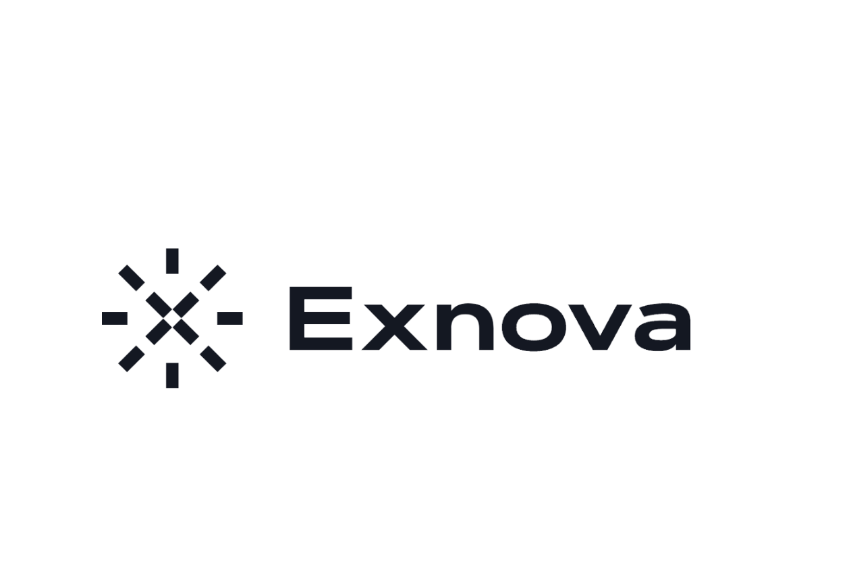Nadex is a fully regulated trading exchange regulated by the CFTC (Commodity Futures Trading Commission), and is legally permitted to accept US residents as clients. Nadex operates in the US but is part of the IG Group which is based in London. They offer a real exchange, allowing both traders to buy and sell positions that are fully open.
Nadex provides a high-quality trading experience, delivering state-of-the-art trading tools and advanced features. Fully documented exchange fees The transparent nature Nadex takes to their service. They describe their business as follows:
“Working to match buyers and sellers of contracts fairly (Nadex does not profit from profit or loss on trades, rather it receives fully disclosed exchange fees)”
Review Summary
- Nadex Demo Account – Yes
- Minimum deposit – $250
- Minimum trade – $1
- Bonus Details – Currently no active Bonus plans.
- Mobile App – NadexGo.
- Signal Service – No
Nadex offers the following features and benefits to its clients:
- Transparent Trading Costs – Nadex is clear about how they are funded.
- Advanced Charting – The charts and technical analysis tools are the best in the binary options arena.
- Education – This firm takes trader education to the next level. There are regular free webinars on how to use the platform, but also how to make a consistent profit.
How to use the trading platform
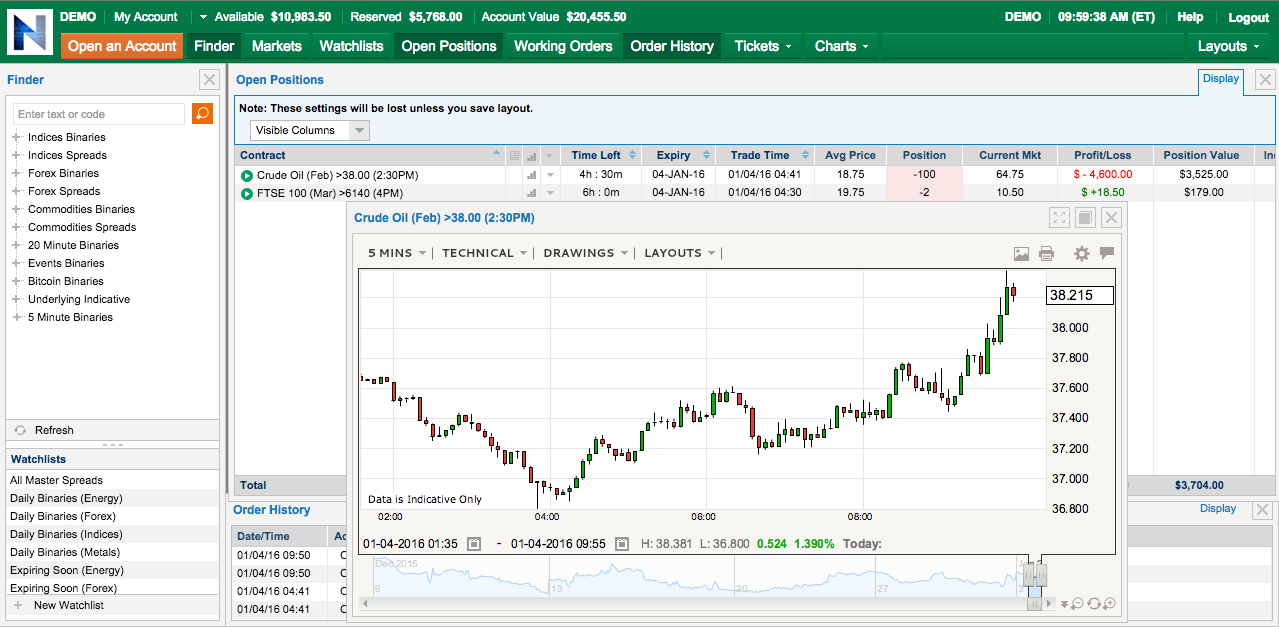
Nadex provides a real exchange trading experience. This means that traders have the option to buy or sell on either side of the asset. Traders can also request their own strike price. If another client wishes to trade the other side of the option, it will be opened at that price.
The first choice to make is the assets to trade. It can be located through the ‘Finder’ window on the left side of the trading platform. Selecting a market opens the time frame on offer for the option’s expiration (are listed in Eastern Time).
The markets window will refresh once the expiry and asset are selected. It will display the current price levels that can be traded. Typically, there will be around 10 price levels – for example, Nasdaq trading offers 10 levels. Each level is traded based on whether the closing price will be above or below the level shown. The settlement price on Nadex binary options is 0 or 100, so the exchange value will fluctuate between 0 and 100. 100 represents a positive outcome, (so an asset finished above or below a certain price) and the option will settle to zero where the option had a negative outcome, so for example where the asset price did not exceed the target price . Remember that a trader can buy or sell both a positive outcome, or a negative one.
Clicking on an asset in the market list, or the ‘Bid’ or ‘Offer’ figures – will trigger the Trading Ticket screen to open. If the Bid or Offer button is clicked, it will result in opening a ticket with ‘Sell’ or ‘Buy’ pre-selected.
The trading ticket confirms the expiry time, price level, bid size and current bid and offer prices. Users then need to click on the sell or buy button (if not already selected) and confirm the trade size (investment amount). Figures below ticket based on trade scale entered
Will highlight Maximum Loss and Maximum Payout – ‘Maximum Loss’ can be intimidating, but the trader can close trades at any time if the price moves against them. Traders can also modify the price – this is the exchange element of Nadex trading. Traders place a price request at a higher or lower level than the current price to wait and find out if their position is ‘matched’.
As each option can be traded openly, clients can close their open trades at any time – profits can therefore be taken, or losses can be reduced. The maximum and minimum figures on the ticket represent the two outcomes if the option is left to expire without further trading.
Once the trade is required, the trader clicks on the ‘Place Order’ button. Once matched, it will appear in the ‘Open Positions’ window. If the trade is ‘matched’ (either all of it, or partially) it will change to the ‘Working Order’ screen. During order matching both ‘Open Positions’ and ‘Working Orders’ will get updated. In addition to these windows, Nadex will also send an email confirmation. Another mail is also sent when an order is settled.
trading options
Nadex offers binary trading on forex pairs, commodities (gold, silver etc) and indices, as well as certain ‘events’ – eg a fed funds rate increase. There is a full range of price levels for each asset, so if a trader is looking for a quick price move in a particular index, or trades longer term in a currency pair, Nadex will provide it.
Nadex offers over 500 contracts to trade at any given time.
touch brackets
Touch Bracket is a new type of contract introduced by Nadex. The contract operates between two ‘brackets’ (a floor price, and a ceiling price). Price moves between these price levels along with the actual asset price. The allure of these levels is that they act as a built in risk management tool, no slippage – guaranteed. The cost of opening a trade is the maximum amount of capital risked.
Flexible ‘micro lot’ trade sizes mean that these contracts can be secured with low capital requirements for novice investors, but scaled up for professional traders to get the most from their leveraged trades.
bitcoin call spread
The bitcoin call spread lets you trade the price of bitcoin (based on the reliable TeraBit IndexSMSM) within a range, between a floor and a ceiling price. As the price of bitcoin changes up and down, so does the value of the bitcoin call spread, but with limits. If the underlying price of bitcoin moves above the ceiling or below the floor, the value of the spread stops moving and stays at its upper or lower limit (depending on whether you are a buyer or a seller). This way, your risk-reward is always limited and stays within the range you define. A limit is your profit target. The second is your guaranteed protection against unlimited losses. The duration of the contract is one week.
mobile app
Nadex offers the best, and most complete, mobile trading app on the market. The application is free, and has been written and optimized for various mobile platforms. The app is called NadexGo
The application operation is quick and importantly sleek, incorporates every feature available on the entire website. From account maintenance to charting, the trading app has it all for traders.
The layout is clear showing all the data a trader needs, making trading very simple. The Dealing Tickets trading area appears identical to the full website platform, as it is already optimized for ease of use.
The NadexGo mobile app includes every feature of the full site, and leads the way in the binary options arena.
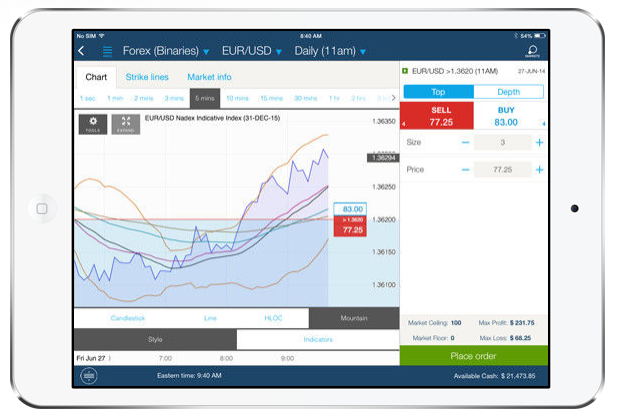
Call spread payout
Payout on Nadex is not easy compared to other brokers – Other brokers do not offer real exchange trading. Binary options will pay based on the strike level that the trader was able to open the option. As an example, if a trader brought in at $50 and the make-up was $100, the payoff is effectively 100% (they could risk $100 for example, and receive $200 at the time the trade is settled). was made), but if they came in at 70 and the make was above 100 then the payout dropped to about 50% (the amount of risk was larger and the profit was smaller).
Certain trading fees apply per lot, up to a maximum of one set. These fees are transparent (you’ll know what each trade will cost), and still represent a ‘better value’ trade than a more traditional option. Full details of Nadex fees are available on their site.
complaints
Nadex doesn’t generate a lot of complaints. On occasion traders struggle with the platform as it is more widely known than ‘the counter’ brokers. The demo account gives traders a chance to get used to the platform before trying out a new strategy, but users can become frustrated where confusion with the platform has led to losing or missed trades.
The education material supplied by the firm is very good. The platform is unique, and it requires specific training materials. Tools range from videos to handbooks and the website also runs a series of regular webinars for traders to walk them through lessons in a live trading setup. Once mastered, the exchange platform performs in a simple manner similar to more familiar platforms. The fees charged for trading are clear and transparent, and again, should not be a reason for complaints.
The brand is definitely not a scam. Owned and operated by IG Group in London, itself regulated by the FCA in the UK. US exchanges are overseen and regulated by the CFTC to offer trading to US residents.
Regulation couldn’t be more stringent for the firm, and users can login, deposit and trade in complete confidence.
Withdrawal and Deposit Methods
Nadex allows US residents to fund their accounts via debit cards, ACH transfers or wire transfers. Non-US residents can use a debit card or wire;
Where a wire transfer is above $5000, Nadex will refund the $20 banking fee to the trading account.
Withdrawals are available via ACH or wire transfer only. Non-US residents can only use wire transfers. The Withdrawal option can be found in the ‘Account Funds’ menu within ‘My Account’. ACH transfer withdrawal is free and takes approximately 3 to 5 days, while a wire transfer will incur a $25 fee, but is typically processed the next day.
Withdrawal details are not straight forward with Nadex so it is worth clarifying them thoroughly before attempting to request a payout. Many of these steps are required due to CFTC regulations – but as delays are a regular problem between traders and their brokers – this is an area to research thoroughly before funding an account. This ensures that there are no shocks and that merchants know what to expect when requesting a withdrawal.
general question
Who controls Nadex?
Nadex is regulated by the CFTC (US Commodity Futures Trading Commission). This represents one of the strongest levels of regulation in the sector.
Who owns Nadex?
Nadex is owned by UK based IG Group. They have offices in London, and are listed on the London Stock Exchange. IG Group also operates UK broker IG Index.
trading hours?
The Nadex website is available 24 hours a day, but assets will only be available to trade based on their regional trading hours. So for example a London based stock will be open for trading only during UK trading hours. Similarly, US assets will be open only in US trading hours. Some forex pairs are traded worldwide and will therefore be open around the clock on weekdays – but trading volumes will vary from time to time.
Is Nadex a broker?
NADEX is not a binary options broker in the “traditional” sense. NADEX is an exchange and an exchange where traders can meet to conduct business. They provide the platform, make sure everything is in line with CFTC and SEC regulations, contract with a clearing house to process all monies and other duties. Every time you place a trade you pay a fee, in the case of NADEX this fee varies but has a maximum limit. The exchange makes its money by facilitating trading, not when you lose.
This is important as it removes any conflict of interest that may arise when trading with an EU style broker. NADEX doesn’t care if you win or lose, they charge a small fee per trade (full details on their site) and this is where their profit comes from. Offshore style brokers make money when you lose, it is not in your best interest to win that’s why “Account Managers”, signals and autotraders offered by a broker are usually scams. What makes NADEX even better, and where the real fun comes in, is the flexibility they provide to trade with you. You are trading against other traders and not on a platform that is heating up the action.
How do you make money on NADEX
How you make money on NADEX is by buying and selling binary options. These options work just like EU style binary in some cases and not in others. On the one hand they can be held till expiry in which case you will lose all or get the maximum payout. On the other hand they are based on set strike prices and can be bought and sold continuously till the time of expiry.
The biggest difference between them and why they trade differently is how they operate. The EU style binary option uses the asset price when you place your purchase as the strike price. If the price goes up or down from there, you will lose or make money, depending on the type of option you have bought. A NADEX binary option is based on a set strike price, chosen from a list of possibilities, and can be in or out of the money.
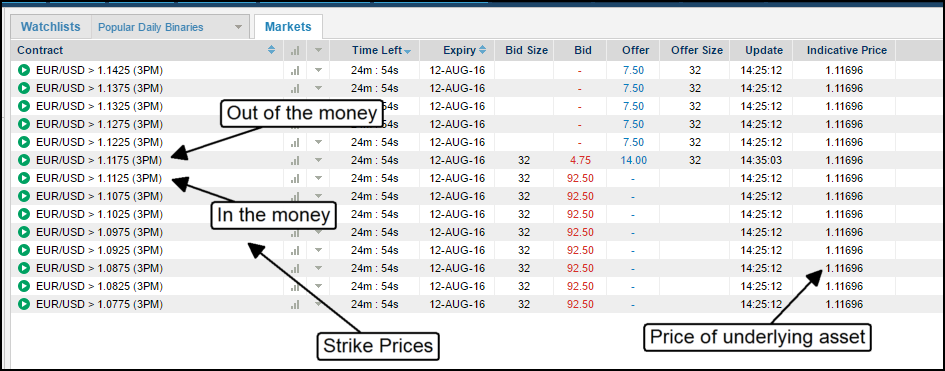
With EU style options you can trade any amount you want, all you do is enter the number in the trade screen. NADEX options sell lots, for example, you want to buy EUR/USD at 1.0545, whatever you choose, you will buy 1, or 2 or 10 lots. The price of each lot will depend on the strike, if it is in or out of the money, and to some extent on market pressure. The price of the options will move between $0 and $100 dollars, with $0 being the minimum payoff and $100 being the maximum. Out of the money options will naturally cost more, out of the money options will cost less. If, at expiration, the option closes in the money, you will receive $100 per lot. If the option closes with $0 in the money you receive. The price will vary depending on the price of the underlying asset before the option expires. The profit you make is the difference between the money you owe and the amount you paid in $100. Typically, in the money options will cost around $50, which means a return on a trade of $50, or 100%, way better than 70% to 80% with EU style binary options.
strategies
To say that NADEX binary options are a bit confusing for new traders is an understatement. There are some real differences between trading these US CFTC regulated binary options and the more traditional spot binaries offered by European and off-shore brokers. The great news though is that these differences open up whole new avenues for trading and profit that would never be available with other forms of binary trading.
Before we move on to the more complex details of opening and closing NADEX positions, let’s review the specific differences between spot binary and NADEX. Off-shore spot binary options brokers, when it comes to standard high/low digital options trading, have two types of positions; calls and hangs up. If you are bullish you buy a call, if you are bearish you buy a put and in both cases you are buying from a broker. If you win the broker pays you, if you lose the broker keeps the money. At no time can you sell an option other than an early out position. In NADEX they only have one type of position, called a lot, and it can be bought or sold. If you are bullish you buy it, if you are bearish you sell it.
How Buying And Selling Works
It works like this. NADEX lots are listed at different strike prices, some are in-the-money, some are out-of-the-money and one or two will be near-or at-the-money. For this discussion I will focus solely on the at-the-money strike for the sake of simplicity and because both long (buy, call, bull) and short (sell, put, bear) positions would cost $50. The thing to remember is that in both the case of buying or selling, you are doing so to open a position. So, buying one NADEX lot is the same thing, buying an EU style call, selling one NADEX lot is the same thing, almost, as buying an EU EU put. The difference is that with NADEX you SOLD TO OPEN, not BUY TO OPEN, so you get CREDIT for doing so.
See in the example below. This chart from NADEX has 1.0868 strike the money for 1PM expiration of EUR/USD. If you want to buy a long position, a call, it will pay you the offer price. This is the price at which another trader is going to Sell Off. If you buy it at $56.00 and the asset closes above the strike price, then in the money, your maximum profit will be $44 which is the difference between what you paid and the maximum payment at expiration, $100. . If you want to sell a short position, enter a put, you will receive the bid price. This is the price at which another trader is willing to buy the option, in this case $50. This means you will receive a $50 credit to your account and get to keep it if the asset price goes out-of-the-money (other traders lose, you win). Your risk is that if the asset price closes in the money, if this happens you are responsible for paying the $100 maximum payout, but not to worry, because you already took $50. It actually only cost you $50 so your risk is $50.
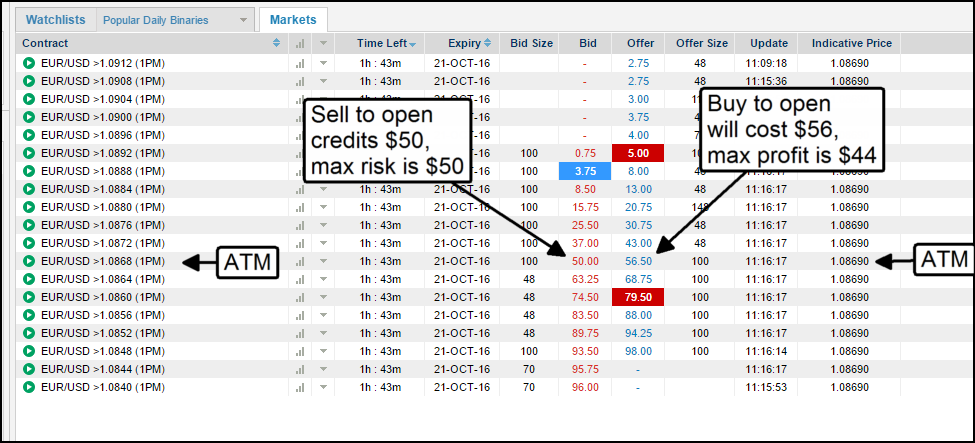
The easiest and best way to profit from NADEX options is to hold them until you get the maximum return at that point. However, some times you may want to close early to lock in profits or cut losses and this is another area where some confusion can arise.
What you have to remember is that you have already opened a position, now you need to close it. If you have bought a long position, a call (Buy to open), then to close it you place the bid and get the bid price. If that price is higher than the price you paid, you will make a profit. If you have sold a short position, sell to open, then to close it you must buy the customer.
open and close
The key is remembering two things. First of all, there is only one type of position you can buy or sell to open. The other thing to remember is that to close your position you must do the opposite of what you did to open it. If you buy to open you sell to close, if you sell to open you sell to close.
A Beginner’s Guide to NADEX
The biggest complaint about NADEX is that it is not easy. Granted, NADEX is not as easy to trade as an offshore, EU or CySEC style digital binary options broker. All in all one of those positions you need to know which direction you want and how much risk you are willing to take.
When you hit, enter the price of the underlying asset at that time is your strike price, you are a winner if the asset prices move in the right direction and you paid the percentage indicated when you bought the option. It is not that simple in NADEX but believe me when I say it is better than any other type of binary trading that I know.
You need three things when it comes to trading on NADEX:
1. Option price is in 0-100 method
Because they are binary in nature, there are only two possible outcomes at expiration, either $0 or $100. If the option closes out of the money you get $0, if it closes in the money you get $100. The details that make trading work are that once the option is live, before it expires, the price will fluctuate between $0 and $100 depending on the underlying asset and market pressure. If the option is out of the money, it will cost less, if it is in the money it will cost more.
Your profit at expiry is the difference between what you pay and what you get. If you pay $45 and receive $100 as the money expires you have a $55 or 122% profit. Please note that I said 122%, which is a better return than what you will find anywhere else. Important to note, you do not need to hold NADEX options until expiration, they can be bought or sold at any time. If your trade moves in the money and your option shows a profit you can sell but you will probably not get the maximum return.
2. Trade in “lots” by the NADEX binary options market
Things that affect the price include the price of the asset, the strike price of the option, and the amount of time until expiration. The offshore broker has no market pressure affecting prices, if you want to trade $500 you enter $500 in the amount box click and the trade is done, you have a position for $500. If you want to trade a lot of $500 and 1 (one) lot costs $50, then with the “lot system”, you would need to buy 10 (ten) of them. If the lot costs $65 then you will only be able to buy 7 (seven) without exceeding your limit.
3. Strike Prices
Each asset will have multiple listed expiries with a number of strike prices available for each. The strike price is the price level at which the option will be in/out of the money. When it comes to pricing options, they will always be trading near $50 which shows a roughly 50/50 chance for the option to move up or down. When the strike price is in-the-money, ie the asset price has already surpassed the strike price, it will cost more, as it is more likely to close profitably. Unless they are fully priced, the strikes will get more expensive in the money going to you. When the strike price is out of the money, that is, when the asset is priced below the strike price, it will cost less than $50 and will make further OTM puts cheaper until they are completely worthless. In the context of standard, directional style trading, an ITM or ATM option is a less risky trade while an OTM option is more risky. Of course, an OTM option with a strong signal that costs only $30 or $40 will return 150% to 230%.
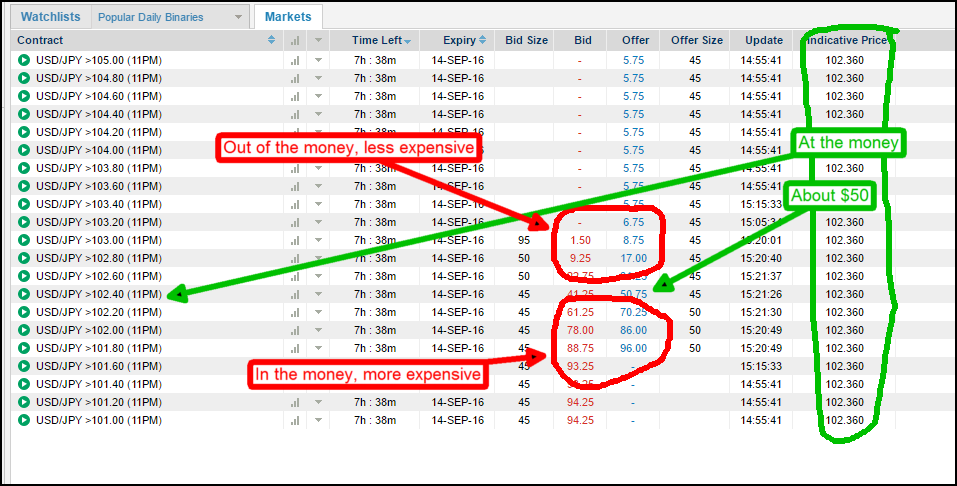
Simple Selling Strategies for NADEX Binary Options
NADEX binary options are not like EU style spot binary, you can actually sell them and get paid. Read on to learn how you can use these simple sales strategies.
Let’s first reiterate that NADEX options are sold in lots, option strikes are preset some in the money and some out of the money, and that all options are worth either $0 or $100 at expiration. During the life of the option, the time between when it is first available for trading and the expiration time, will fluctuate between $0 and $100 depending on the strike and the movement of the underlying asset. In the case of a bull position, a position in which you bought a strike in the belief that prices will go higher, your profit will be the difference between the price you paid for that position and the amount you liquidated, either $0. Will happen. or $100.
If the option expires out of the money and you get $0, you suffer a loss, the cost of the position. If the option expires in the money, you receive $100 and make a profit, $100 minus the cost of the option. If the option was bought when at the money it probably cost $50 and returned almost $50, or 100%.
Hence, in case of a bearish position you move in the same way as you would as a buyer. You “sell” the strike, meaning you pay the buyer on the other side of the position with whom you match. If the buyer put in $40, you would pay $60, which is $40 minus the $100. The most you can lose is $60. If the option expires at zero, you make a profit, while the buyer profits if it expires at $100. In this case, if the binary turns out to be worthless, you will get back the buyer’s $40 plus your $60 for the $100 down payment.
Remember, at-the-money options cost $50 per lot. If you sell one for $50 and it closes in the money, you pay $100, which is $50 of your money and $50 you receive in option premium. If the option closes out-of-the-money, which is what you want, you get to keep the premium (the owner of the option keeps a worthless contract, you don’t need to pay anything) and make a profit of that amount. Is.
- Buying a NADEX / Bullish Position – You buy the option strike, pay the ask price, and take advantage of the difference between the cost of the option and $100. Your risk is the price of the option.
- Selling on NADEX / Bearish Positions – You sell the option strike, get the bid price, and that profit if the option moves out of the money. Your risk is the difference between what you received and the $100.
The mechanics of buying and selling options on NADEX opens up a lot of possibilities. One of the simplest and probably the most effective hedging strategies for directional binary options trades. Hedging is when you use one position to offset the costs of another, or help maximize profits before expiration. Think about it. You take a signal on a bullish trade and buy an ATM for $50. The underlying asset goes up to your next resistance target and stalls out but you are able to sell the next higher strike for $50 at the same time. This means your net cost is now $0 dollars, all you have to do is wait until expiration. If the asset continues to hold up between the two strikes, you make the maximum profit, if not you lose nothing.
More advanced traders can target non-directional strategies using options that have been sold. These strategies work best in markets when asset prices are low or when they are capped by resistance. One way is to target money hoards that can be sold for credits. For example set up this trade for the S&P 500. Price is trending lower in the near term with two strike prices that are close enough to the money to hold, but safe enough relative to price action. Please note, these are already in the money so there is no need for any price movement. Sell these for a combined credit of $31.50, free and clear and you only have to keep them for 5 minutes.

Some of the links to third party websites included on our website are affiliate links. This means that we may receive a commission or fee if you click on a link that takes you to a third party website or if you purchase a product from a third party website.




